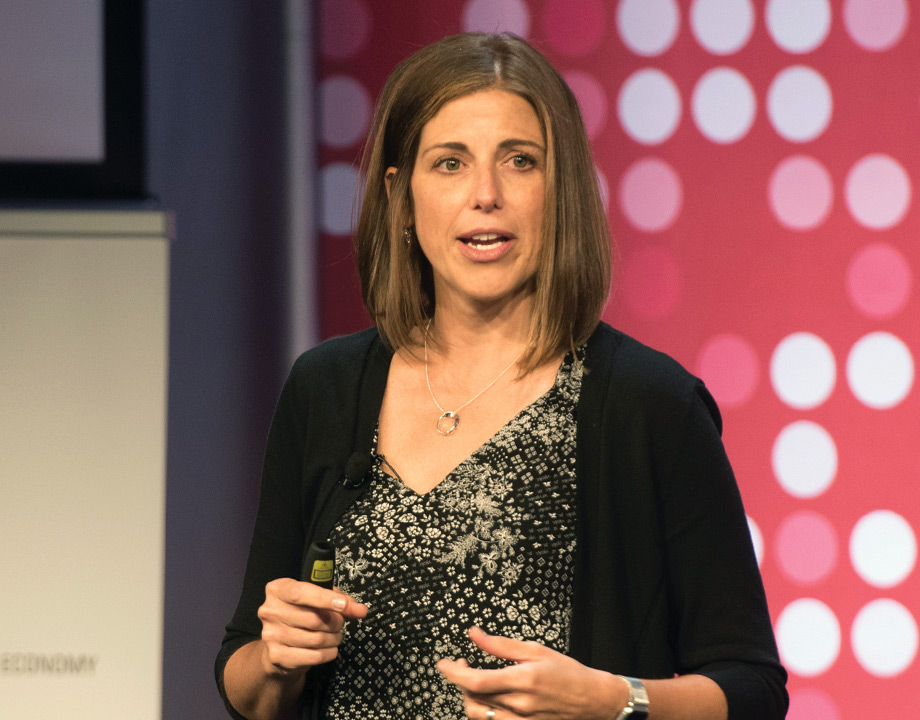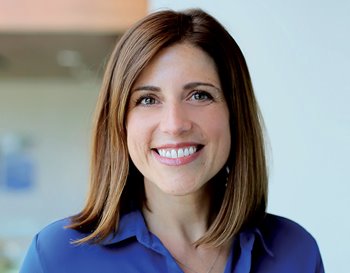7 Questions with GE Renewable Energy CTO Danielle Merfeld
7 Questions with GE Renewable Energy CTO Danielle Merfeld


The CTO of GE Renewable Energy Danielle Merfeld is optimistic about the future of digital energy. Photo: GE Renewable Energy
Danielle Merfeld is the VP and CTO of GE Renewable Energy. She leads technical efforts to develop differentiated products and services across the broadest renewable energy portfolio in the industry, which combines onshore and offshore wind, blades, hydro, storage, utility-scale solar, and grid solutions as well as hybrid renewables and digital services offerings. Merfeld received her B.S. degree in electrical engineering from the University of Notre Dame, and Ph.D. in Electrical Engineering from Northwestern University. She is passionate about the development and promotion of talented women, and is the co-leader of GE's global Women's Network.
Q1: As the CTO of GE Renewable Energy what do you currently do and what are your goals?
D.M: The business is a grouping of several businesses that have their own technology and products, ranging from onshore wind and offshore wind to hydro power to hybrid technology. I focus on making sure that we are being strategic in making technical investments, especially looking at cross-cutting and next-generation technology that can benefit the broadest possible grouping of these teams. My responsibilities include overseeing and supporting some of our key product launches. We are launching the largest offshore 12-megawatt turbine, which is called the Haliade-X. We're also innovating around pumped hydro storage, which will be a key to providing stabilization on the grid. The overall driving goal of all of this is to reduce the cost of renewable energy and to make it more reliable and accessible across all regions and markets.
Q2: Renewable energy is a hot space right now and there is a lot of competition in this field, especially in offshore wind. Why do you think GE will succeed?
D.M: I have a lot of confidence in us because of our breadth of experience, the depth of talent within our teams, and the passion that each employee brings to our mission of making sure that no one ever has to choose between affordable, reliable, accessible or sustainable energy. We pulled in experts from our aviation, power, digital, and even our healthcare business, to provide feedback during our design and manufacturing phases. We were able to think through all the contingencies and use new materials and approaches that we never would have found just within the wind industry. This idea of bringing in talent from across the company, across other industries, is something that GE is uniquely able to do.
Q3: Digitalization is changing industries. What are the key digital trends transforming the energy sector?
D.M: The first one is controls, which are like the brains of any industrial system. Digitalization is giving us the ability to upgrade the intelligence of this brain by enabling the ability to have any of our assets become software-defined assets. We can change the behavior of how these machines work just by changing their control systems in key areas like predictive maintenance. The second one is additive manufacturing. Digitalization is one of the fundamental tenets of additive because of the software that’s required in the design and manufacturing of parts.
Q4: Where do you see this digital transformation leading the energy industry in the next decade?
D.M: It will absolutely enable you to be more cost-effective and more reliable, which is really the entry point for the energy transformation. Technology has to produce better outcomes at all levels–in terms of economics, sustainably, and reliability. We can't just solve some parts of that equation: It has to be transformative across every area.
Q5: Where the job opportunities will be in the clean energy space and how can young engineers prepare for it?
D.M: The job opportunities will be plentiful and span across just about every engineering discipline. I have noticed working with many engineering teams across multiple disciplines that systems engineering is becoming more ingrained in all of those disciplines. Because the systems that we’re designing and using are becoming more complex and interconnected, it’s important for the students to get a sense of how vital teamwork is in designing the solutions of tomorrow. So I think it’s important for young engineers to develop an expertise in an area they’re passionate about while also learning how to be effective in delivering across a highly diverse team.
Q6: What career advice would you give to young engineers, especially women, aspiring to pursue a career in STEM?
D.M: I would encourage young engineers, especially women, to take one step at a time. Too often I’ve seen young women just take themselves out of the running for promising opportunities, say, a job that may require a lot of travel. They avoid pursuing certain opportunities, because they worry about a later fork in the road that hasn’t yet materialized. I encourage them to take the next step that feels right at the time. Remember you can always make changes to your trajectory later. So just taking that step and doing what feels exciting and challenging as your next step is really the best way to grow your career.
Q7: You are at the forefront of the effort to change perceptions of gender in the workplace, especially in the field of STEM. What more can be done?
D.M: First, I would say, we all need to become more aware of our own biases. We all have biases and that holds us all back from achieving more collectively. And we may never remove those biases. But if we're self-aware enough to recognize when they're at play, we can then pause and act with a better sense of fairness. The second thing that companies really can drive is to change our processes and to take bias out of them. For example, we all have processes that we use to recruit talent and to retain and promote our engineers. In all those steps, there is an opportunity to correct some of this human bias, whether it's the language of our job descriptions, how we do an interview, or who participates in the interview. So we operationalize all these processes in a way that ensures the best talent is recognized and nurtured.
Chitra Sethi is managing editor.
Q1: As the CTO of GE Renewable Energy what do you currently do and what are your goals?
D.M: The business is a grouping of several businesses that have their own technology and products, ranging from onshore wind and offshore wind to hydro power to hybrid technology. I focus on making sure that we are being strategic in making technical investments, especially looking at cross-cutting and next-generation technology that can benefit the broadest possible grouping of these teams. My responsibilities include overseeing and supporting some of our key product launches. We are launching the largest offshore 12-megawatt turbine, which is called the Haliade-X. We're also innovating around pumped hydro storage, which will be a key to providing stabilization on the grid. The overall driving goal of all of this is to reduce the cost of renewable energy and to make it more reliable and accessible across all regions and markets.
Q2: Renewable energy is a hot space right now and there is a lot of competition in this field, especially in offshore wind. Why do you think GE will succeed?
D.M: I have a lot of confidence in us because of our breadth of experience, the depth of talent within our teams, and the passion that each employee brings to our mission of making sure that no one ever has to choose between affordable, reliable, accessible or sustainable energy. We pulled in experts from our aviation, power, digital, and even our healthcare business, to provide feedback during our design and manufacturing phases. We were able to think through all the contingencies and use new materials and approaches that we never would have found just within the wind industry. This idea of bringing in talent from across the company, across other industries, is something that GE is uniquely able to do.
Q3: Digitalization is changing industries. What are the key digital trends transforming the energy sector?
D.M: The first one is controls, which are like the brains of any industrial system. Digitalization is giving us the ability to upgrade the intelligence of this brain by enabling the ability to have any of our assets become software-defined assets. We can change the behavior of how these machines work just by changing their control systems in key areas like predictive maintenance. The second one is additive manufacturing. Digitalization is one of the fundamental tenets of additive because of the software that’s required in the design and manufacturing of parts.
Q4: Where do you see this digital transformation leading the energy industry in the next decade?
D.M: It will absolutely enable you to be more cost-effective and more reliable, which is really the entry point for the energy transformation. Technology has to produce better outcomes at all levels–in terms of economics, sustainably, and reliability. We can't just solve some parts of that equation: It has to be transformative across every area.
Q5: Where the job opportunities will be in the clean energy space and how can young engineers prepare for it?
D.M: The job opportunities will be plentiful and span across just about every engineering discipline. I have noticed working with many engineering teams across multiple disciplines that systems engineering is becoming more ingrained in all of those disciplines. Because the systems that we’re designing and using are becoming more complex and interconnected, it’s important for the students to get a sense of how vital teamwork is in designing the solutions of tomorrow. So I think it’s important for young engineers to develop an expertise in an area they’re passionate about while also learning how to be effective in delivering across a highly diverse team.
Q6: What career advice would you give to young engineers, especially women, aspiring to pursue a career in STEM?
D.M: I would encourage young engineers, especially women, to take one step at a time. Too often I’ve seen young women just take themselves out of the running for promising opportunities, say, a job that may require a lot of travel. They avoid pursuing certain opportunities, because they worry about a later fork in the road that hasn’t yet materialized. I encourage them to take the next step that feels right at the time. Remember you can always make changes to your trajectory later. So just taking that step and doing what feels exciting and challenging as your next step is really the best way to grow your career.
Q7: You are at the forefront of the effort to change perceptions of gender in the workplace, especially in the field of STEM. What more can be done?
D.M: First, I would say, we all need to become more aware of our own biases. We all have biases and that holds us all back from achieving more collectively. And we may never remove those biases. But if we're self-aware enough to recognize when they're at play, we can then pause and act with a better sense of fairness. The second thing that companies really can drive is to change our processes and to take bias out of them. For example, we all have processes that we use to recruit talent and to retain and promote our engineers. In all those steps, there is an opportunity to correct some of this human bias, whether it's the language of our job descriptions, how we do an interview, or who participates in the interview. So we operationalize all these processes in a way that ensures the best talent is recognized and nurtured.
Chitra Sethi is managing editor.




